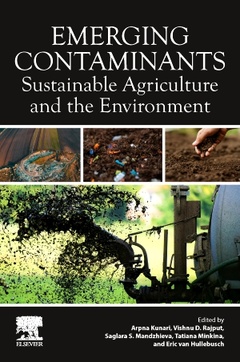Emerging Contaminants Sustainable Agriculture and the Environment
Coordonnateurs : Kumari Arpna, Rajput Vishnu D., Mandzhieva Saglara S., Minkina Tatiana, van Hullebusch Eric D.

Emerging Contaminants: Sustainable Agriculture and the Environment provides a thorough, comprehensive, and interdisciplinary overview of the many categories of emerging pollutants, including pharmaceuticals, insecticides, personal care items, and industrial chemicals, that are currently impacting the environment. With insights into the exposure associated consequences on crops and edible plants, this book is designed to enable foundational understanding as the basis for future research, as well as providing practical application guidance in current environments. Water resource shortages, declining arable land, environmental contamination with different exiting or ECs, shortcomings in the procedures for protecting cultivated land, and inefficiencies in the management of land tenure rights continue to pose challenges for agricultural sustainable development around the world. This book focuses on the impacts of ECs on sustainable agricultural production and explores possible response approaches. Following an introduction to environmental contaminants, this book discusses their fate in soils, presents the most up-to-date analytical methods for detecting them in different environmental matrices, and addresses current regulatory restrictions. Finally, this book ends with a chapter dedicated to conclusions and future perspectives. Emerging Contaminants is an ideal resource for researchers and professionals from a variety of sciences including agricultural, plant, and environmental.
2. Insights into the analytical procedures for the detection of emerging contaminants from the water, soils, and sediments
3. Occurrence of microplastics and nanoplastics in terrestrial ecosystem and their toxicological impacts in plants
4. Occurrence of emerging contaminants in soils and impacts on rhizosphere
5. Ubiquity of microplastics and phtalates in aquatic ecosystem and ecotoxicological conerns
6. Phytotoxicity, cytotoxicity, and genotoxicity of pharmaceutical products along with their transport and fate
7. Appraisal on accumulation of nano-enabled agrochemicals in plants with subsequent morpho-physiological implications
8. Endocrine-disrupting chemicals exposure induced alterations in the germination, growth, and physiological traits of plants
9. Nanomaterials induced phytotoxicity and challenges to agriculture
10. Personal care products in agroecosystem: ubiquity, sources, and toxicity insights
11. Contamination of arable soils with perfluorinated compounds and their exposure mediated modulations in plants
12. Effects of veterinary antibiotics on the soil properties
13. Pollution of silver and silver nanoparticles in the ecosystems and their interactions with plants and soil microbiota
14. Perchlorate stress?in plants: Insights into growth and physiological consequences
15. Contamination of arable soils with bisphenol-A and phthalates along with their consequent impacts on the crops
16. Bioremediation of emerging pollutants: a sustainable remediation approach
17. Exploitation of plants for the removal of emerging contaminants from the environment: a green technology
18. Cyanotoxins pollution in waterbodies and soils impose potential risks to the surrounding flora
Dr. Vishnu D. Rajput is a Researcher in the Academy of Biology and Biotechnology, Southern Federal University, Russia. He has 12 years of research experiences in the field of environmental pollution especially on PAHs, priority heavy metals and metallic nanoparticles, and their impacts on plant performance, soil microbial functionalities and plant-microbe-interactions. He earned his doctorate degree from the Chinese Academy of Sciences, Beijing, China. He has published 49 peer reviewed research articles, 1 book and 8 book chapters. Dr. Rajput recently received “Highly Qualified Specialist Status by the Ministry of Internal Affairs of the Russian Federation and Southern Federal University, Russia.
Dr. Saglara S. Mandzhieva is a Researcher and Head of the “Monitoring of Biosphere Laboratory of Southern Federal University, Russia. She earned her PhD in Soil Science and is currently researching biogeochemistry of trace elements in soil, environmental soil chemistry, and remediation using physicochemical treatment methods. She has published 354 scientific publications and is a member of the Eurasian Soil Science Societies and the Russian
- Focuses on the extensive emission of ECs raising concerns of toxicity in crop plants, in the environment, and also to human beings via the food chain
- Includes examples and real-world insights
- Highlights interaction of different categories of ECs with crop plants their toxicity and fate in the environment
Date de parution : 03-2024
Ouvrage de 434 p.
15x22.8 cm
